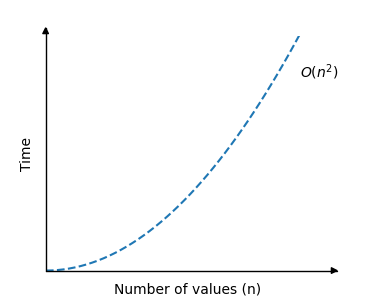DSA Bubble Sort Time Complexity
See the previous page for a general explanation of what time complexity is.
Bubble Sort Time Complexity
The Bubble Sort algorithm goes through an array of nn values n−1n−1 times in a worst case scenario.
The first time the algorithm runs through the array, every value is compared to the next, and swaps the values if the left value is larger than the right. This means that the highest value bubbles up, and the unsorted part of the array becomes shorter and shorter until the sorting is done. So on average, n2n2 elements are considered when the algorithm goes through the array comparing and swapping values.
We can start calculating the number of operations done by the Bubble Sort algorithm on nn values:
Operations=(n−1)⋅n2=n22−n2Operations=(n−1)⋅n2=n22−n2
When looking at the time complexity for algorithms, we look at very large data sets, meaning nn is a very big number. And for a very big number nn, the term n22n22 becomes a lot bigger than the term n2n2. So large in fact, that we can approximate by simply removing that second term n2n2.
Operations=n22−n2≈n22=12⋅n2Operations=n22−n2≈n22=12⋅n2
When we are looking at time complexity like we are here, using Big O notation, factors are disregarded, so factor 1212 is omitted. This means that the run time for the Bubble Sort algorithm can be described with time complexity, using Big O notation like this:
O(12⋅n2)=O(n2)__O(12⋅n2)=O(n2)––––––––––––––
And the graph describing the Bubble Sort time complexity looks like this:

As you can see, the run time increases really fast when the size of the array is increased.
Luckily there are sorting algorithms that are faster than this, like Quicksort.
Bubble Sort Simulation
Choose the number of values in an array, and run this simulation to see how the number of operations Bubble Sort needs on an array of nn elements is O(n2)O(n2):
300
Operations: 0
The red line above represents the upper bound time complexity O(n2)O(n2), and the actual function in this case is 1.05⋅n21.05⋅n2.
A function f(n)f(n) is said to be O(g(n))O(g(n)) if we have a positive constant CC so that C⋅g(n)>f(n)C⋅g(n)>f(n) for a large number of values nn.
In this case f(n)f(n) is the number of operations used by Buble Sort, g(n)=n2g(n)=n2 and C=1.05C=1.05.
Read more about Big O notation and time complexity on this page.

